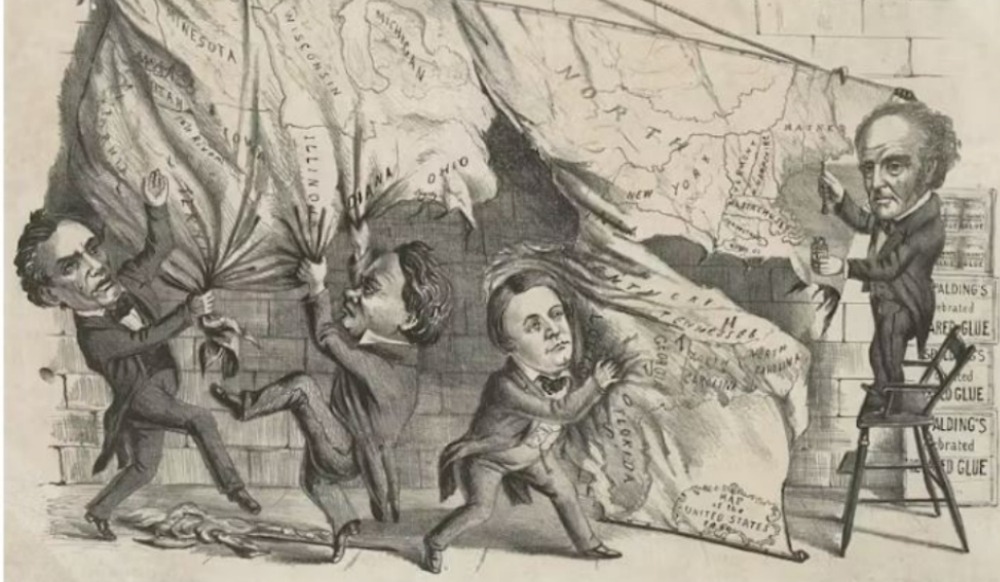Robert W. Merry is an important national historian and journalist who grew up in Tacoma, was educated at the U.W., and now lives (mostly) on Whidbey Island. His usual books deal with an important, second-tier president (James Polk and William McKinley) as well as the prominent journalist brothers, Joseph and Stewart Alsop.

His new book, Decade of Disunion, is just out, and deals with the fatal momentum of the terrible 1850s, ending in the Civil War. To structure that unwieldy decade, Merry uses the story of two leading and contrasting states, South Carolina and Massachusetts, to focus the story and allow leading figures to dominate the foreground.
The book is timely, since we are a very divided nation, but it is not encouraging. The leading politicians of those years are rendered as complex and articulate figures, so it is a good test of democracy’s problem-solving aspects. These dominant figures propose various solutions short of war. One was the Compromise of 1850, letting individual territories vote for slavery or freedom, stoutly defended as “popular sovereignty” by Illinois Sen. Stephen A. Douglas, Lincoln’s presidential rival. (That ploy, leaving it to the voters, as Trump has tried to do with the abortion issue, blew apart in Kansas.)
Another was Lincoln’s electoral finesse: allow slavery in the Deep South but don’t allow it to spread to new territories. (The book admirably presents Abe Lincoln as the ambitious, shrewd politician that he was.) That came apart when Lincoln decided in his famous House Divided speech that the effort to keep the nation half-slave and half-free would not work. Charles Sumner of Massachusetts, a deeply conflicted and compelling antislavery figure, attempted to argue that the founders of the nation conceived it in liberty, while states could allow slavery for a few more years. However, the unexpected Dred Scott decision by the Supreme Court, which universalized the property rights of slavery, blew that Sumner fix out of the water.
Merry has an interesting approach as a historian. He pretty much follows the press accounts of the story, so the reader and the main actors don’t know the ending of the story. A play of speculation and fault-finding is absent from such an approach, which adds to the suspense and improvisation and anguish. An example (page 139): “Hardly anyone in 1835, however, conceived of the nation that would emerge within just a dozen years, stretching across the continent from ocean to ocean.”
This tunnel vision enables some deeply conflicted figures such as Sen. Sumner and South Carolina Gov. James Hammond to emerge as the tormented Hamlets of the drama. Ultimately, the focus on Puritan Massachusetts and hedonistic South Carolina set the tragic stage for an unresolvable conflict.
One hopes in reading this riveting book, that democracy can somehow resolve these tragic conflicts. The usual explanations do not offer comfort – a string of mediocre presidents in the 1850s; the grip of domination by the planter aristocracy of the South; the rhetorical excesses of a figure like William Lloyd Garrison; the late maturity of Lincoln.
One touch of drama is the overshadowing of key figures by the first and second generation of political leaders, (the Founders, then Clay, Webster, and Calhoun) now fading away and tormenting the next generation with mighty ambitions.
There is no resolution, and democracy falters. In the end I am struck by something fatal in the contradictions of a Democratic Republic that preclude a peaceful resolution. The “Decade of Disunion” threatens to become a Nation of Disunion. Even today.
Discover more from Post Alley
Subscribe to get the latest posts sent to your email.

Erik Larsen’s new book; ‘The Demons of Unrest’ is another nice commentary on this period, as well as on the present day.
I suppose I’ll have to read Bob Merry’s book, as that period of American history holds a morbid fascination for me. Bob and I worked together at the UW Daily in 1966-1967. He was the editor and I wrote a basketball column. We argued politics incessantly, and I’m guessing that to this day, his conservatism and my liberalism remain irreconcilable. 🙂
I recommend some other authors highly. William W. Freehling’s two-volume The Road to Disunion, and Michael Holt’s The Rise and Fall of the American Whig Party, are essential reading for examining the mindsets of the principal players. And, of course, David Hackett Fischer’s monumental work, Albion’s Seed, gives the basic context for the regional cultures that produced those mindsets.